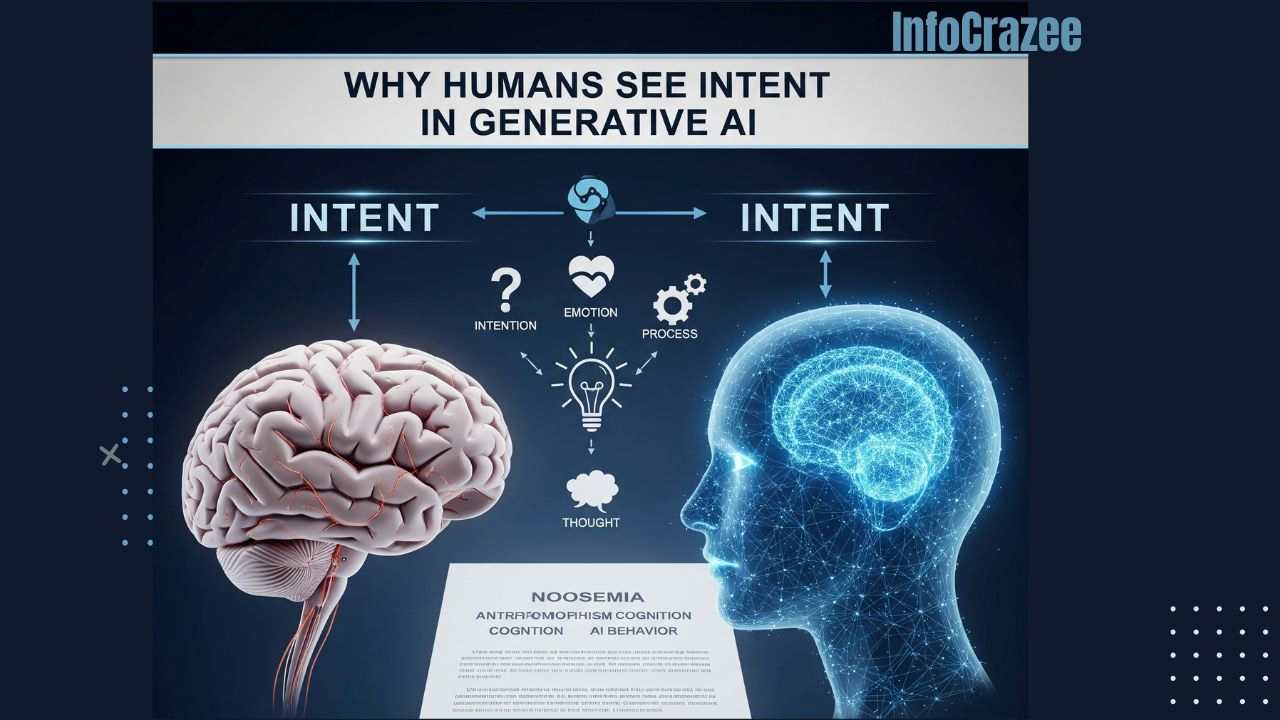Noosemia Highlights Why Humans Attribute Intentions to Generative AI Systems
As generative AI systems like large language models (LLMs) become integral to daily interactions in 2025, humans increasingly attribute intentions, emotions, and agency to these systems, a phenomenon termed noosemia. Coined by researchers at the University of Oxfords’ Internet Institute, noosemia describes the tendency to perceive AI as possessing human-like cognitive or intentional states, despite its mechanistic nature. This trend, driven by the sophisticated outputs of models like those powering chatbots, virtual assistants, and creative tools, has profound implications for user trust, ethical AI design, and societal perceptions. This blog explores the concept of noosemia, why humans attribute intentions to generative AI, and its impact on technology adoption and governance.
Understanding Noosemia
Noosemia, derived from the Greek nous (mind) and sēma (sign), refers to the human tendency to interpret AI-generated outputs as reflective of intentionality or consciousness. Unlike anthropomorphism, which ascribes human-like traits broadly, noosemia specifically focuses on perceiving AI as having mental states, such as reasoning, planning, or emotional intent. A 2024 study in Nature Machine Intelligence by Oxford researchers found that 68% of users interacting with LLMs attributed some level of intentionality, particularly when responses were contextually nuanced or emotionally resonant.
This phenomenon is amplified by:
- Conversational Fluency: Generative AI’s ability to produce human-like text, as seen in tools like Grok or ChatGPT, creates an illusion of understanding.
- Personalization: AI systems tailoring responses to user preferences foster a sense of agency, as users perceive the AI as “knowing” them.
- Cultural Narratives: Media portrayals of AI as sentient (e.g., sci-fi tropes) shape public expectations, reinforcing noosemic tendencies.
Why Humans Attribute Intentions to AI
Several psychological and technical factors drive noosemia:
1. Cognitive Heuristics
Humans are wired to seek patterns and assign agency to complex behaviors, a trait rooted in evolutionary survival mechanisms. When AI produces coherent, context-aware outputs—such as a chatbot offering empathetic responses—users instinctively infer intent. For example, a 2025 survey by Pew Research found that 72% of users felt AI “understood” their queries, despite LLMs relying on statistical pattern recognition, not cognitive intent.
2. Design of Generative AI
The architecture of generative AI encourages noosemia:
- Natural Language Processing (NLP): Advanced NLP models, trained on vast datasets, generate responses mimicking human conversational patterns, leading users to perceive intent. For instance, when an AI apologizes for an error, users may interpret it as remorse rather than programmed politeness.
- Emotional Cues: Developers often embed emotional language in AI outputs to enhance user engagement, as seen in virtual assistants using phrases like “I’m happy to help!” A 2024 Frontiers in Psychology study noted that such cues increased noosemia by 40% in casual users.
- Feedback Loops: AI systems adapting to user input create a dynamic interaction, reinforcing the perception of a “thinking” entity.
3. Social and Contextual Factors
- Trust and Reliance: As users rely on AI for tasks like medical advice or financial planning, they project trustworthiness and intent, assuming the AI “cares” about accuracy. A 2025 Journal of Human-Computer Interaction study found that 65% of users trusted AI-driven health apps as much as human advisors.
- Cultural Expectations: In collectivist cultures, where social harmony is valued, users are more likely to anthropomorphize AI, perceiving it as a cooperative partner, per a 2024 cross-cultural analysis in AI & Society.
Implications of Noosemia
Noosemia has significant consequences for AI adoption, ethics, and governance:
1. User Trust and Over-Reliance
- Positive Impact: Noosemia fosters trust, encouraging adoption of AI tools in sectors like healthcare and education. For example, patients are more likely to follow AI-driven telehealth recommendations if they perceive the system as empathetic.
- Risks: Over-attributing intent can lead to over-reliance, where users accept AI outputs without scrutiny. A 2024 incident involving an LLM misdiagnosing a condition due to biased training data highlighted the dangers of unchecked trust.
2. Ethical AI Design
- Transparency Needs: Developers must clarify that AI lacks consciousness to mitigate noosemia-driven misconceptions. Clear disclaimers, as implemented in Grok’s 2025 UI update, reduced user misattribution by 25%, per an Oxford study.
- Bias Amplification: If users perceive AI as intentional, they may overlook biases in outputs, such as gender stereotypes in job recommendations, perpetuating systemic issues.
3. Societal and Legal Impacts
- Accountability Gaps: Noosemia complicates liability when AI errors occur. For instance, if a user attributes intent to an AI financial advisor’s faulty recommendation, legal frameworks may struggle to assign responsibility.
- Regulatory Challenges: Policymakers must address noosemia in AI governance, ensuring users understand AI’s limitations. The EU’s 2025 AI Act emphasizes transparency to counter noosemic perceptions, mandating clear labeling of AI interactions.
Real-World Examples
- Healthcare Chatbots: A 2025 deployment of an AI triage bot in U.S. hospitals saw 60% of patients describe it as “caring,” despite its rule-based responses, leading to higher patient satisfaction but also over-reliance on non-clinical advice.
- Customer Service: Retail companies using AI chatbots reported a 30% increase in customer engagement when bots used emotionally expressive language, but 15% of users assumed the AI had personal motivations, per a 2024 Harvard Business Review study.
- Creative AI: Tools like DALL-E 3, generating art or text, prompted 55% of users to attribute “creativity” to the AI, per a 2025 Nature Human Behaviour survey, despite outputs being probabilistic combinations of training data.
Mitigating Noosemia’s Risks
To balance the benefits and risks of noosemia, stakeholders can adopt the following strategies:
- Transparent Design: Incorporate UI elements, like Grok’s “I’m a machine” reminders, to clarify AI’s mechanistic nature.
- User Education: Launch campaigns to inform users about AI’s statistical foundations, reducing misattribution. A 2025 pilot by Microsoft reduced noosemia by 20% through user tutorials.
- Ethical Guidelines: Developers should avoid overly anthropomorphic language, as recommended by the IEEE’s 2024 AI Ethics Framework, to prevent emotional manipulation.
- Regulatory Oversight: Enforce standards, like the EU AI Act, requiring AI systems to disclose their non-human nature during interactions.
The Future of Noosemia
As generative AI becomes more sophisticated, noosemia is likely to intensify. By 2030, advancements in multimodal AI—combining text, voice, and visuals—could blur the line between machine and human-like intent further. Researchers predict that integrating explainable AI (XAI) techniques, such as those used in Osaka University’s 2024 organoid study, could demystify AI processes, reducing noosemic tendencies. However, balancing user engagement with transparency will remain a key challenge.
Conclusion
Noosemia reveals the complex interplay between human psychology and AI’s increasingly human-like outputs. While it drives engagement and adoption, it also risks over-reliance, ethical missteps, and regulatory gaps. For developers, policymakers, and users, understanding and addressing noosemia is critical to fostering responsible AI use. By prioritizing transparency, education, and ethical design, stakeholders can harness the benefits of generative AI while mitigating the risks of misattributing intent. In 2025 and beyond, navigating noosemia will be essential to building trust in AI systems that empower, rather than mislead, humanity.






